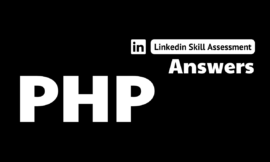
accounting linkedin assessment answers
1. Which is the appropriate term for an incurred cost that cannot be changed by any decision?
- variable cost
- opportunity cost
- sunk cost
- previous cost
2. An employee who makes a sale, ships the goods, and bills the customer violates which control activity?
- review and reconciliation
- segregation of duties
- audit verification
- assignment of responsibility
3. Which answer best represents an activity-based costing (ABC) approach?
- ABC is easier to implement than traditional cost systems
- ABC is less costly than traditional cost systems.
- ABC is more accurate than traditional cost systems.
- ABC provides the same data as traditional cost systems
4. Your client's company wants to determine the relationship between its monthly operating costs and a potential cost driver. The output of regression analysis showed this information:
• intercept coefficient = 5,500
• x variable 1 coefficient = 82.70
• -square = 0.96
What is the company's monthly cost equation?
- y= $82.70x + $5,500
- y= $0.96x + $5,500
- y = $82.70x + $0.96x + $5,500
- Y= $5,500x + $82.70
5. How do variable costs and fixed costs act within the relevant range?
- Fixed costs per unit remain constant and variable costs per unit vary.
- Variable costs per unit remain constant and fixed costs per unit vary.
- Both total variable costs and total fixed costs vary.
- Both total variable costs and total fixed costs remain constant.
6. Which statement about negative confirmation requests is correct?
- Unreturned negative confirmation requests prove that there are no issues with account balances.
- Unreturned negative confirmation requests do not provide strong audit evidence.
- Negative confirmation requests are an appropriate choice when detection risk is low.
- Negative confirmation requests are an effective tool if the auditor strongly suspects that account balances have been understated.
7. Which answer can be defined as an investment center's contribution margin less the fixed costs that are traceable to the investment center?
- return on investment (ROI)
- net income
- residual income
- segment margin
8. Which statement about a perpetual inventory system is true?
- Average costs are based entirely on unit cost simple averages.
- LIFO cost of goods sold will be the same as in a periodic inventory system.
- A new average is calculated under the average cost method after each sale.
- FIFO cost of goods sold will be the same as in a periodic inventory system.
9. When applying a cost-volume-profit analysis (CVP), certain assumptions must be respected. Which answer is not one of these assumptions?
- The unit sales price will remain constant.
- The unit fixed cost will decrease
- The cost behavior is expressed as intersecting straight lines
- Actual unit variable cost will vary over the production range
10. What is the formal method of analysis applied by management to identify appropriate cost drivers and effects on the costs of production?
- life-cycle costing
- cost-benefit analysis
- profitability analysis
- activity analysis
11. If an auditor is expected to detect the overstatement of sales, what should the auditor trace transactions from?
- customer purchase orders to the sales journal
- sales journal to the shipping documents
- shipping documents to the cash receipts
- cash receipts to the purchase orders
12. Which type of business would be most likely to use a job order costing system?
- an electric car producer
- a wood milling company
- a beverage manufacturer
- a law firm specializing in injury law
13. What do you call a situation where more than one person collaborates to circumvent existing internal controls?
- assignment of responsibility
- segregation of duties
- fraud prevention
- collusion
14. How is the asset-turnover ratio calculated?
- sales revenue divided by net income
- average operating income divided by total assets at the end of the period
- sales revenue divided by average total assets
- average total assets divided by sales revenue
15. What is conversion cost the sum of?
- direct materials cost + administration cost
- direct labor cost + manufacturing overhead cost
- direct materials cost + marketing cost
- direct materials cost + manufacturing overhead cost




